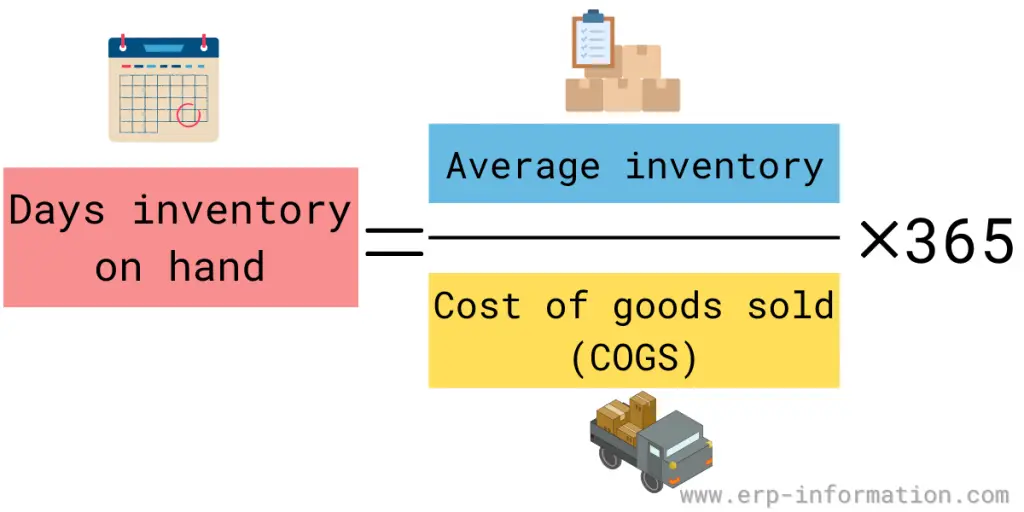You’ve been tasked with calculating the company’s days of inventory, but you need help figuring out where to start.
The days of inventory formula is a calculation used to determine the number of days it takes for an organization to sell its inventory.
In this article, we’ll define the days of inventory formula (calculation), walk you through how to do it, and discuss the benefits and importance of accurate inventory figures.
In this article, we interchangeably used the terms days in inventory and days of inventory. So first, let us know about days of inventory.
What is days of inventory?
The days of inventory (DOI), Days in inventory (DII), or days of supply is a metric used by businesses that estimate the number of days a business would take to sell through its current inventory at the current sales rate.
It is a very important calculation because it helps companies determine how long they can keep their current stock before ordering more.
The days in inventory calculation take into account the average number of days it takes to sell a particular type of inventory and the average number of days it takes to restock that inventory.
If the days in inventory are high, the company has more than enough stock to meet demand, while the days in inventory are low, which means the company does not have the required stock to meet demand.
What is the days of inventory formula?
The days of inventory formula is a calculation used to measure how quickly a company sells through its inventories in a given period. The days of inventory formula indicates the time required for an organization to sell all its stock or goods at any given time.
The days of inventory is calculated by dividing the average inventory held during a period by its cost of goods sold (COGS) during that same period and multiplying it by the number of days in that period.
Days of inventory formula
The days in inventory formula is:
Days of inventory = (Average Inventory / Cost of Goods Sold) × 365
Where:
Average inventory is the average on-hand inventory value over the period, which means the begging and ending value of the year’s inventories.
It can be represented as Average inventory = (Beginning inventory + ending inventory)/2
The cost of Goods Sold is the cost of the goods sold during the period.
365 is the number of days in a year.
Another way of representing the formula is,
Days in inventory = 365 / Inventory turnover
Here inventory turnover = Cost of goods sold / Average inventory
Days of inventory formula example
Let us assume that A company’s beginning inventory value is $40,000 and its ending inventory value is $50,000.
The cost of goods sold is $200,000,
And the days in the year are 365
Now we calculate the days of inventory using the days of inventory formula.
Formula is
Days of inventory = (Average inventory/COGS) X 365
Let us calculate the Average inventory first.
That is average inventory = (Beginning inventory + ending inventory)/2
= ($40,000 + $50,000) / 2
= $45,000
Now apply this value to the formula
Days of inventory = ($45,000 / $200,000) X 365
= 82.125
Approximately 82 days is the days of inventory of that company.
Importance of days of inventory
It helps to plan and control stock levels.
Knowing your average inventory days can help you plan your stock levels more effectively. That is because you can calculate how many days of stock you have on hand and how many days of stock you need to order to meet your desired levels. As a result, it can help avoid running out of stock and overstocking your inventory.
It helps you manage cash flow.
If you know your average days in inventory, you can also use this one to help you manage your cash flow. For example, suppose you know that you will need to reorder inventory in 30 days.
In that case, you can factor this into your cash flow projections to have enough cash available to cover the costs associated with ordering and stocking new inventory.
It helps you make better business decisions.
When it comes to making business decisions, having accurate information is key. And one piece of information that can be helpful when making business decisions is your company’s average days in inventory. This number tells you a lot about your company’s performance from a stock perspective.
For example, if the average days in inventory number is getting higher, it could mean that your company needs to do a better job of managing its stock levels.
On the other hand, if the average days in inventory number is getting lower, it could mean that your company is doing a good job of managing its stock levels and might be able to afford to be less conservative with its orders.
It helps you evaluate your suppliers.
Another thing that the average days of inventory number can tell you is how efficiently your suppliers are working. If the number is high, it could mean that your suppliers must keep up with demand or ship on time.
That can lead to problems with customer demand and lost sales opportunities. But conversely, if the number is low, it could mean that your suppliers are overproducing or shipping early, which could lead to excess inventory and increased costs.
It helps you assess product demand.
The average days in inventory can also give you an idea of how much product demand there is for a particular item. For example, if the days in inventory number is low, it could mean a high demand for that item, and you should consider increasing your orders from your suppliers.
It helps you track your cost of goods sold.
Your cost of goods sold (COGS) can also be impacted by days in inventory. If your days in inventory are increasing, it could mean that you are spending more on goods than before, and it might be time to reconsider your stock levels or pricing strategy.
It helps you identify trends over time.
Finally, tracking the days in inventory numbers over time can help you identify trends in your stock levels. These trends can help you anticipate future needs and make changes to keep your inventory levels in check.
For example, suppose days in inventory are increasing over time. In that case, it could mean a trend toward lower demand for a particular item, and you might need to adjust your inventory levels accordingly.
On the other hand, if days in inventory are decreasing over time, it could mean that there is a trend toward higher demand for a particular item, and you might need to increase your inventory levels.
Overall, days in inventory can be an important metric for any business as it can help you plan and control your stock levels, manage cash flow, make better business decisions, evaluate suppliers, assess product demand, track your cost of goods sold, and identify trends over time.
Knowing the days in the inventory formula and how to calculate it helps you make the most of this metric.
FAQs
What are the benefits of the days of inventory formula?
The days of inventory formula helps organizations understand how quickly their inventories are selling, allowing them to manage their supply chain better. Additionally, understanding the days of inventory can help organizations anticipate trends and make decisions about pricing or promotions that will increase sales.
What is inventory turnover?
Inventory turnover measures how frequently a company sells its inventory during a given period. It is calculated by dividing the cost of goods sold by the average inventory level. This ratio measures how efficiently a company uses its inventory to generate sales. A high ratio shows that a company is selling its inventory quickly, and a low ratio suggests that a company could be more efficient in its use of inventory.
What is the difference between inventory turnover and days in inventory?
The difference between inventory turnover and days in inventory is that inventory turnover is a measure of how many times a company sells its entire stock of goods per year. In contrast, days in inventory are a measure of the number of days it would take to sell the entire inventory at the current sales rate.
Conclusion
In conclusion, the days of inventory formula is a valuable metric that companies should track to manage their inventories and maximize efficiency effectively.
Knowing the days of inventory formula and how to calculate it can help businesses make informed decisions that will benefit their bottom line.


